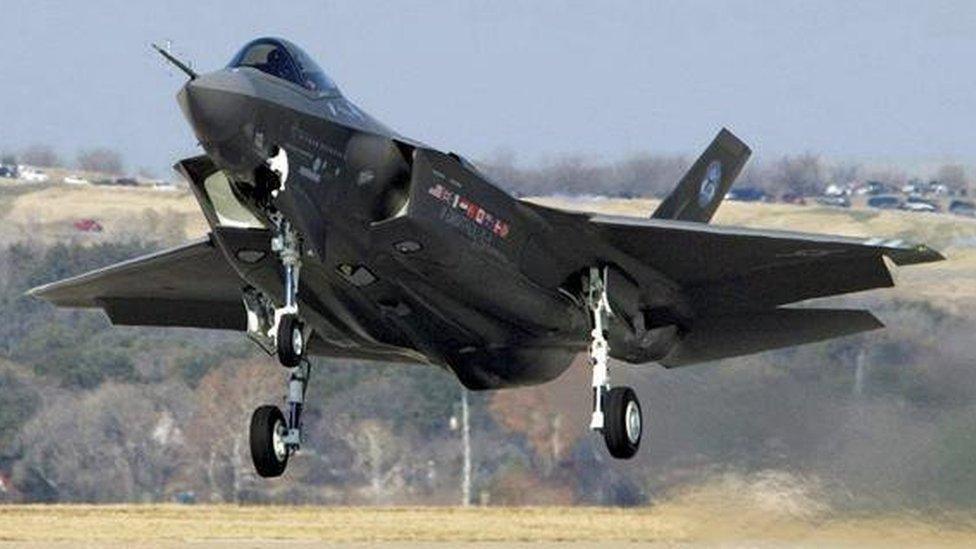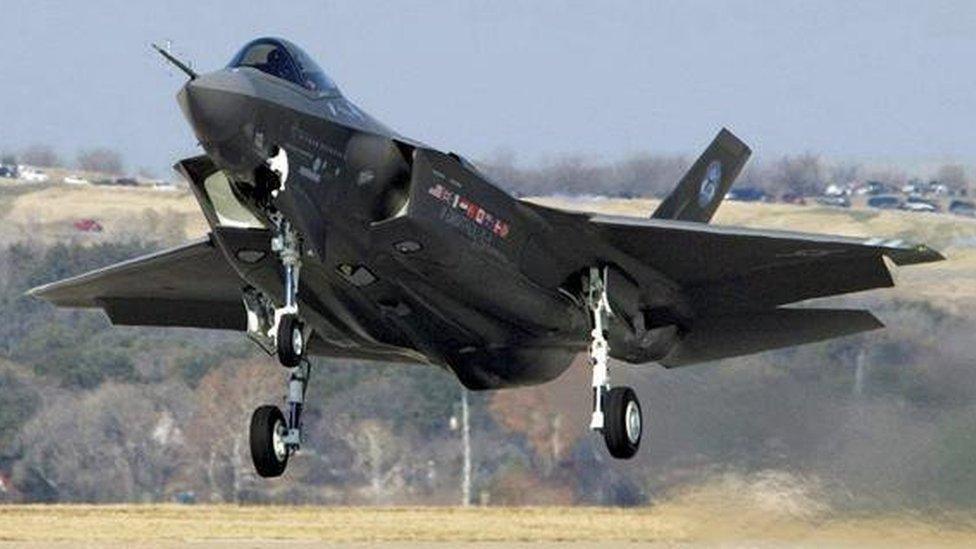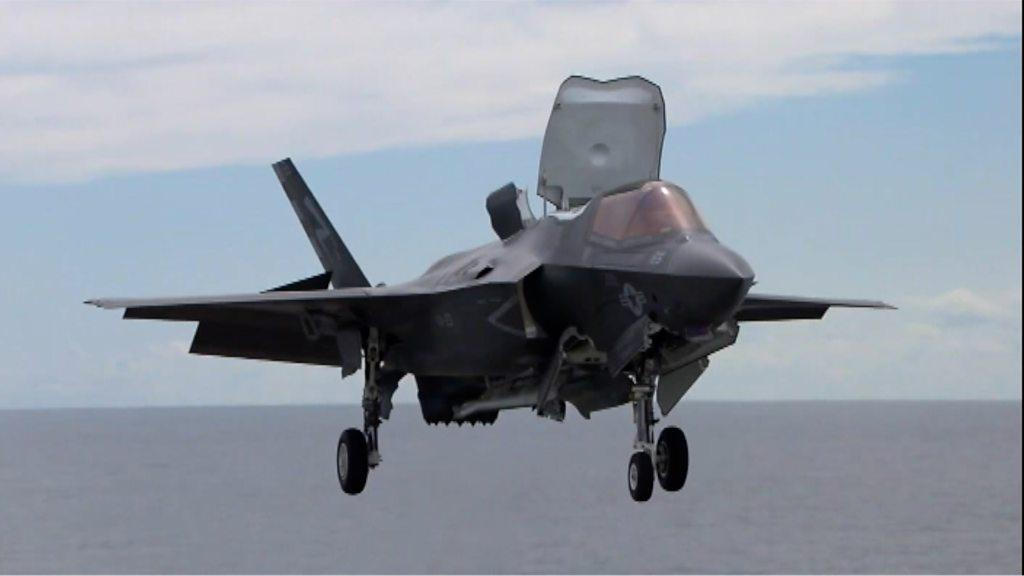Why the RAF's new F-35 jets matter
- Published

A F-35B Lightning II jet in flight
The arrival of the first four F-35B Lightning II combat aircraft in Britain - a programme more widely known as the Joint Strike Fighter - marks a significant moment for the RAF in a year during which it has been celebrating its centenary.
The entry into service of the F-35B - which will be flown by both RAF and Royal Navy pilots - heralds the revival of Britain's ability to launch sea-borne operations from aircraft carriers. But it is much more than this.
The F-35B, according to Douglas Barrie, senior Fellow for Military Aerospace at the IISS, "is the first aircraft that will enter British service designed from the outset to be low-observable, that is stealthy. This provides greater survivability than previous aircraft designs."
Aviation analyst Justin Bronk of RUSI agrees, noting that the aircraft represents "a step change in the RAF's ability to conduct operations against states with modern surface to air missile defences - such as Russia's S-400.
It can conduct strike missions and act as a superb intelligence gathering and target-acquisition asset in a way which would be extremely risky for existing fighters like Typhoon."
The F-35 is not just able to find and hit targets itself. Its sensors can suck up information and pass this to other aircraft or combat systems, giving a whole new level of situational awareness in complex air operations. The presence of the F-35 effectively ups the capabilities of older aircraft engaged in the same mission.
World's most expensive weapons programme
The F-35 is currently the largest and most expensive weapons programme of its type in the world, with projected global sales of over 3,000 aircraft. The programme is likely to last for some 30 to 40 years.
It is already being purchased by the US Air Force and Navy, along with at least 10 other countries, including the UK, Italy, the Netherlands, Turkey, Norway, Denmark, Australia, Israel, Japan and South Korea. Rather like the McDonnell Douglas Phantom during the 1960s and 1970s, and more recently the F-16, this US-built aircraft will equip virtually all the most sophisticated air forces of Washington's allies.
But there the similarity with its predecessors ends. The F-35 is a state-of-the-art, so-called "fifth generation" aircraft, but with a combat system that will evolve over time taking on new features and capabilities.
F-35 fighter jet simulator unveiled
So far only the United States has fielded a mature fifth generation fighter, the F-22. Russia has tried to produce one - the troubled Su-57, and China has its J-20A in early operational service, as well as a prototype design of more limited capabilities, the FC-31.
For all its claimed technical sophistication the F-35 has been controversial from the outset, not least due to its hefty price-tag. Fifth generation capabilities do not come cheap.
Future cost-cutting
A Lockheed Martin spokesperson says that for the latest production lot of the aircraft, lot 10, the F-35A comes in at $94.3m (£70m) and the F-35B version at some $122.4m per aircraft. Costs are going down though. Between Lots 1 and 10, the price of the F-35B version has gone down by 38% and that for the F-35A, by 60%. By 2020, Lockheed Martin says they have a commitment to get the price of the A version down to some $80m per aircraft.
Cost is a pressing problem for the RAF with the weakening pound pushing up the cost of purchases denominated in US dollars; adding to the already gaping black hole in the equipment budget. As yet it is not clear how many aircraft Britain will eventually buy.
According to Douglas Barrie "at the outset of the project up to 150 were to be bought by the UK. This was subsequently revised to 138, of which 48 have already been ordered. While further orders are highly likely, the 138 target is increasingly under pressure. This is the result of several factors including potentially changing priorities in the medium-to-long term."
After the initial tranche of 48 jets, Justin Bronk argues that there might well be a case for switching at least some of the orders for the F-35B (the short take-off and vertical landing version) to the US Air Force's standard F-35A, which, he says, "is cheaper, simpler and has longer range and a better weapons payload, but of course would not be able to operate from Britain's Queen Elizabeth Class aircraft carriers."
How many aircraft countries like Britain decide to buy matters for the overall unit cost of the aircraft. Canada has already cancelled its planned purchase of 65 of the jets. Even in the United States there are serious concerns about the F-35's affordability. The problem, as Justin Bronk sees it, "is not so much the up-front acquisition cost but the operating and sustainment costs through its service life. The US," he says, "is already finding the jet significantly more expensive to operate than hoped."
Stealth or not?
Accordingly the F-35 needs all the good publicity it can get and earlier this month the Israeli Air Force complied, announcing that its F-35's had already flown on combat missions. The IDF published an unusual - some might say provocative photo - of one of their F-35's flying just off the Lebanese capital, Beirut. This was all part of Israel's increasingly public messaging campaign; a signal to Iran and its allies of the IDF's intent to push back on Iranian influence in the region.
Experts noticed something unusual in the photograph.
The aircraft seemed to be fitted with radar reflectors to change its signature - in this case possibly to make it more visible; in other words negating its stealth characteristics. If this assessment is accurate, it suggests that - well aware of powerful prying Russian radars in Syria - the Israelis want to reveal as little as possible of the F-35's radar signature for when they actually need it to perform in its full stealth mode.

Israel has ordered 50 F-35s
Stealth aircraft are, despite popular misconceptions, not invisible. A combination of careful design and high-tech surfaces and operating procedures - weaponry being carried inside the aircraft's fuselage for example, render it much less visible to air defences.
How close is Russia watching?
Concerns about Russia's ability to monitor the aircraft's performance is also a factor in the growing tensions between Washington and another of the aircraft's purchasers, Turkey. Ankara has opted to buy up to 100 aircraft, the first of which is due to be delivered in late June despite growing opposition to the deal on Capitol Hill.
But its growing tilt towards Moscow, and in particular its decision to purchase advanced Russian surface-to-air missiles, raises the possibility of Russian technicians being able to electronically eavesdrop on the F-35's operational patterns from a privileged vantage point. As Justin Bronk notes, "given the jet's absolutely central place within NATO's future air combat mix, this is not a threat anyone takes lightly."
- Published22 May 2018

- Published18 January 2018

- Published16 July 2010